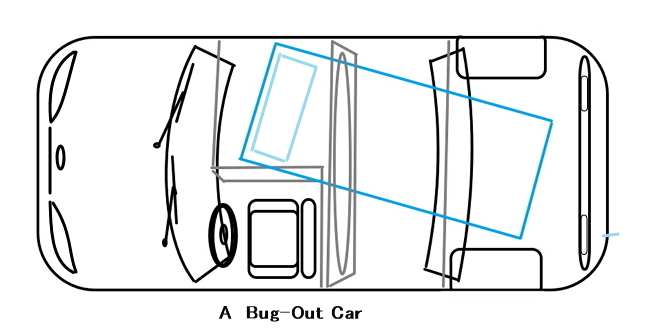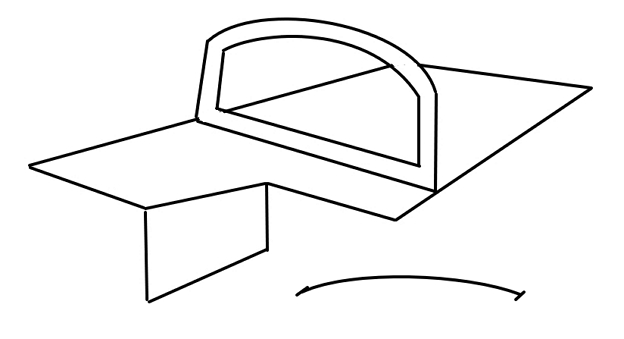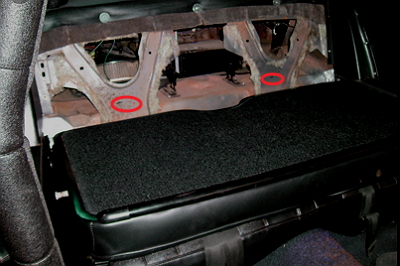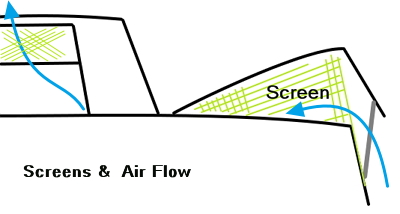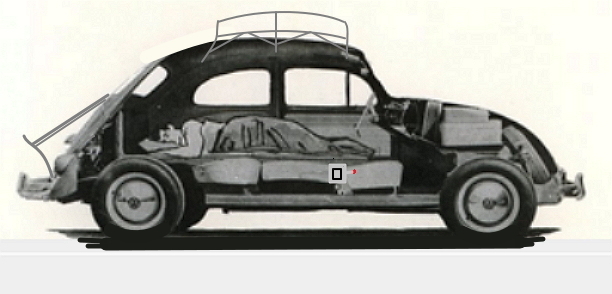A Bug-Out Car
Ok, so what is bugging-out ? And why a specially modified car
to Bug-Out in ? Why ? What's the purpose of this ?
Essentially it means to exit in a hurry whether by choice or
adverse circumstances. By choice it may be for opportunity or a better way or life. By circumstances it may be just to escape the frustrations of a too confined way of life or it may be due to unworkable personal circumstances such as a bad divorce, riots, forest fires, floods, hurricanes, tornado's, etc.
Ultimately it's about being prepared. Pack & keep a 4 day survival kit of food, clothing, and necessary supplies to sustain you. At one end is the single person who wants to be self reliant and travel to sight see or clear his/her mind. The other extreme end would be the people known as "Prepper's". (whose BOV's are
quite different than this & prep them for the end of the world)
A Bug-Out Car is a lower cost option to a Van so an individual could have the basic mobility and shelter of a Van rig. A front drive larger 4 door sedan or station wagon may offer better fuel economy, be more readily available, less expensive to buy & modify, and have ready to travel in more quickly. (Bug-Out is all about quickly) The living space may be more restricted but the Nomad who would choose this way would only be traveling and sleeping in the Bug-Out Car. Everything else would be external using public services. (like Planet Fitness, Laundry-Mat's, and eating at Hospital Cafeterias, Church dinners, Senior Centers, or buying Grocery Store Deli foods for meals) In the end it is a different method of thinking for those new to this way of life
Every vehicle will be different so the following suggestions will be limited to the "abstract". Ideally a 2000 to 2013 Chevy Impala would be plentiful, cheap, & large enough to fit a 39 x 75 (or smaller) twin mattress. Plus up to 32 mpg hw.
A 4 door front drive vehicle would first need to have all of the seats removed. If there are braces behind the rear seat back, those would need to be removed and sharp edges eliminated. The floor of the back seat area and front passengers area would need to be made level with the floor of the trunk. This may require being built up with 2x4's or 2x6's etc and deck screws used to anchor it solid. Then 1/2 inch particle board installed to make the floor. This then covered with carpet remnants.
When this flooring area is completed a Tonneau Cover would need to be fabricated to hide it from site. Only the drivers seat would be exposed and a flap that drops to the floor beside the driver's right side would further conceal the flooring area. This cover could also have a panel behind the driver with a plastic window like a Taxi to seal off the back seat area. In this manner only a few cubic feet of the car would need the A/C while traveling. So a little better fuel economy obtained as only 1/3 of the interior would require A/C from the Vent setting.
The Tonneau Cover could be made of any of a number of materials. Something matching the color of the car that doesn't draw much attention & look's like a sun shade. Brown wrapping paper and tape could be used to make the template. The A/C isolation window could be made as an extra item to use when traveling. A couple of bowed Cover braces would hold the cover up even with the windows with one behind the drivers seat and one above the rear passengers seat. These may rest at the bottom of the rear door windows. Snaps, velcro, or magnets would hold the cover in place.
The drivers seat should be a comfortable bucket seat for extended trips, like something from a nicer Honda or Toyota. This will require some mounting modifications so it will be high and solid enough to operate the car safely.
Understand that this is just a concept plan with suggestions. There is no way this could be standardized for all cars. But older cars are in estate sales every day with low mileage and for only a few hundred dollars. Often working men buy them for commuter cars, drive them a few months, and then resale them. (so they don't have to invest much in them. But for a resourceful Nomad, someone in college or trade school, those with limited means, or someone who has to put something together quickly and.....Bug-Out.....this may be a solution.
Shown are the braces behind the rear seat back. Note the red circles. Removal allows room for the mattress, storage, and space to shift around in. The car will be a one person RV thus parked when sleeping so the bracing won't be as critical as it would be in normal passenger transport service.
Another simple feature for ventilation could be made from an inexpensive roll of plastic window replacement screen. It would
fit in a partly open trunk lid. A couple of metal bars could be made to hold the open trunk lid open & secure.
Similarly, a screen for the drivers window would allow for it to be open some to allow for cross ventilation thru the sleeping area. Here the flap beside the drivers seat could be folded back over the top of the Tonneau or by using clothes pins the flap could be opened part of the way to regulate air flow or light as needed.
These screens, like the Tonneau, could be be made from a paper template. The trunk lid could be adjusted for suitable air flow as well.
You are only limited by your imagination. Use it & begin to think.
Now, imagine your Bug-Out Car modified to get exceptionally
high gas mileage with very little cost or effort. Some are making these mods to their vehicles now and proving it can be done. The idea started in the early 1930's with Charles Pogue and his 200 mpg carburetor and later work carried out by Tom Ogle. Watch.
If you were to set your vehicle up like this you would want to make sure you could at least maintain 65 mph. By keeping up with traffic you wouldn't attract the unwanted attention of law enforcement and you would still enjoy great mileage.
Could the Bug-Out Car optimized like this in the hands of low income Gen Z's, do to Van Rigs what USB Jump Drives did to CD's & DVD's ?
Gasoline and Kerosene evaporate from a liquid to a gas state at nearly the same temperature. (around 140 F to 150 F). In a Kero Space Heater the liquid
evaporates in the fiberglass fibers of the wick that reaches very high temps.
Gasoline in a modern carburetor isn't a very efficient evaporation. Maybe 20%.
Bubbling air thru gasoline may be a more efficient method of producing a more pure gasoline vapor. Some early motorcycles used cotton rope winding in their carburetors to create a vapor induction for those small engines.
Example of a front drive Chevrolet Malibu Maxx 2004 converted
to serve as a Bug-Out Car. The tonneau cover would be similar to an indoor tent to cover the bed and storage area. The adjustable supports for the Tonneau cover are shown in full upward position for sleeping. When traveling they would be lowered for better visibility
So, imagine you have your Bug-Out Car built and ready to go now.
Where do you bug out to ? How do you live out there ? Take care of your personal hygiene, dirty laundry, and avoid legal problems on the road ? How can you be prepared for all of this ?
Below are some helpful links for Bugging-Out.
Follow the 70 degree F weather thru the year in the USA
Some may remember the mid sixties when accessory items for the VW Bug were plentiful. The "recliner kit" for the front seats
was popular, so the seating could transform into a large bed. The
rear seat back was often removed for this. (as shown) But both the VW BUG and VW Van have left enduring solutions for anyone
thinking of traveling and living in a converted vehicle.
